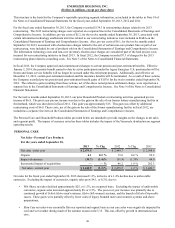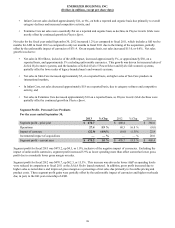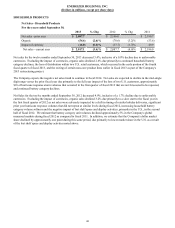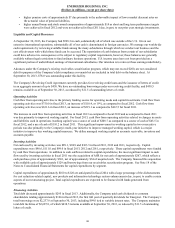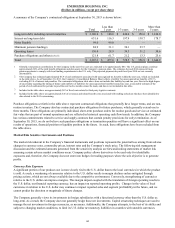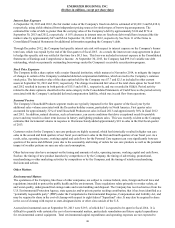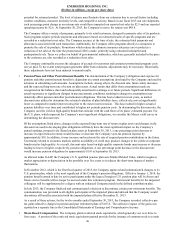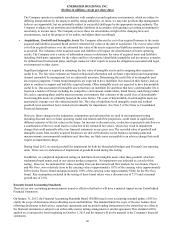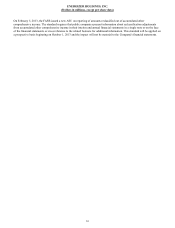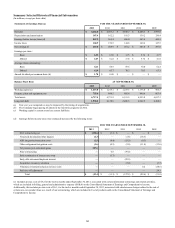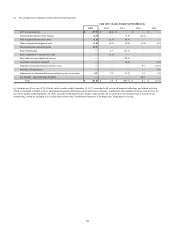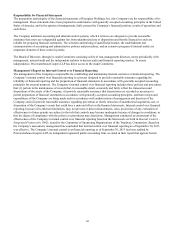Energizer 2013 Annual Report Download - page 55
Download and view the complete annual report
Please find page 55 of the 2013 Energizer annual report below. You can navigate through the pages in the report by either clicking on the pages listed below, or by using the keyword search tool below to find specific information within the annual report.
ENERGIZER HOLDINGS, INC.
(Dollars in millions, except per share data)
From time to time the Company may employ foreign currency hedging techniques to mitigate potential losses in earnings or
cash flows on foreign currency transactions, which primarily consist of anticipated intercompany purchase transactions and
intercompany borrowings. External purchase transactions and intercompany dividends and service fees with foreign currency
risk may also be hedged. The primary currencies to which the Company’s foreign affiliates are exposed include the U.S. dollar,
the Euro, the Japanese Yen, the British pound, the Canadian dollar and the Australian dollar. Certain of the foreign exchange
contracts have been designated and are accounted for as cash flow hedges.
The Company enters into foreign currency derivative contracts to hedge certain existing balance sheet exposures. Any losses on
these contracts would be fully offset by exchange gains on the underlying exposures, thus they are not subject to significant
market risk. The change in estimated fair value of the foreign currency contracts for fiscal 2013 and 2012 resulted in income of
$4.9 and expense of $1.9, respectively, and was recorded in Other financing items, net on the Consolidated Statements of
Earnings and Comprehensive Income. In addition, the Company has entered into a series of forward currency contracts to
hedge the cash flow uncertainty of forecasted inventory purchases due to short term currency fluctuations. These transactions
are accounted for as cash flow hedges. At September 30, 2013 and 2012, the Company had an unrealized pre-tax gain on these
forward currency contracts accounted for as cash flow hedges of $1.5 and unrealized pre-tax loss of $5.9, respectively, included
in Accumulated other comprehensive loss on the Consolidated Balance Sheets. Contract maturities for these hedges extend
into 2015. There were 80 open contracts at September 30, 2013 with a total notional value of approximately $339.
In addition, the Company enters into foreign currency derivative contracts which are not designated as cash flow hedges for
accounting purposes to hedge existing balance sheet exposures. Any gains or losses on these contracts would be offset by
corresponding exchange losses or gains on the underlying exposures; thus, they are not subject to significant market risk. There
were 13 open foreign currency derivative contracts which are not designated as cash flow hedges at September 30, 2013 with a
total notional value of approximately $118.
The Company has investments in Venezuelan affiliates. Venezuela has been considered highly inflationary under GAAP since
January 1, 2010. In addition, the conversion of local monetary assets to U.S. dollars is restricted by the Venezuelan
government. In February 2013, the Venezuelan government devalued its local currency in relation to the U.S. dollar from 4.30
per U.S. dollar to 6.30 per U.S. dollar. In addition, the Central Government also suspended the alternate currency market
administered by the central bank known as SITME that made U.S. dollars available at a rate higher than the previous official
rate, generally in the range of 5.50 per U.S. dollar. The Company had been utilizing SITME to obtain U.S. dollars for the
import of product on a regular basis since the establishment of this market, as access to U.S. dollars at the official exchange rate
was greatly limited. We continue to monitor this situation including the impact that continued restrictions on the ability to
exchange local currency for U.S. dollars may have on our future business operations, including our ability to import products
from other Energizer affiliates for sale in the Venezuela market and how such restrictions or other future developments may
impact our operating results in Venezuela. At September 30, 2013, the Company had approximately $62 in net monetary assets
in Venezuela. Due to the uncertainty of the availability of U.S. dollars at the official exchange rate, the possibility of further
devaluation of the local currency, the lack of clarity on what, if any, future alternatives will be available to obtain U.S. dollars,
and at what price such alternatives may offer U.S. dollars, the Company is not able to predict the amount of future imports to
Venezuela or the ultimate price it will be able to convert local currency to U.S. dollars to pay for future imports. See Note 4 of
the Notes to Consolidated Financial Statements.
In addition, the Company has affiliates located in certain developing markets such as Argentina, which may be susceptible to
greater volatility of inflation and currency exchange rates, as well as government pricing and import controls. While these
affiliates are not considered material in relation to the consolidated company as a whole, there could be negative impacts to
operating results in certain markets, if inflationary pressures, exchange volatility and government controls negatively impact
the Company's ability to operate effectively and profitably.
Commodity Price Exposure
The Company uses raw materials that are subject to price volatility. At times, the Company has used, and may in the future use,
hedging instruments to reduce exposure to variability in cash flows associated with future purchases of certain materials and
commodities. At September 30, 2013, there were no open derivative or hedging instruments for raw materials or commodities.
45





